Index

Review: The fastest air-cooled GTX 480 around
It’s been a few months since we’ve heard about Point of View and TGT Tuning team’s joint efforts on overclocking graphics cards. So far, the work has paid off and the offspring, GTX 460 BEAST, already has the title of the fastest factory overclocked GTX 460. Now that the dust has settled around the aforementioned card, we’re ready to talk about other cards in the offer. Today, we’re talking about GTX 480, so far the fastest Nvidia DirectX 11 card which, with a little help from TGT team, runs like the wind.
Unlike the reference card where the GPU runs at 700MHz, shaders at 1400MHz and the memory at 3700MHz, Point of View/TGT Ultra Charged card runs at 763MHz for the GPU, 1536MHz for the shaders and 3800MHz for the memory.
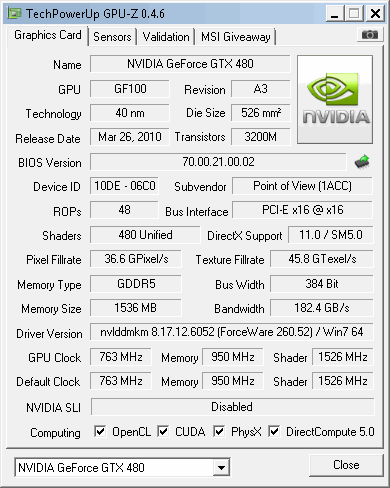
GTX 480 was announced at the end of March and can currently be found at about €400. GTX 480 Ultra Charged card, which we’re discussing today, is priced at about €460, here .
We’re talking about a really powerful graphics card with plenty of potential. The stronghold of this chip is tessellation, a very important part of DirectX 11 and this is what this chip is really good at. Unfortunately, the potential has been severely limited by high temperatures and cooling noise. It has long been noted that with adequate cooling, the GTX 480 can run much, much better, and partners naturally heard the call. Point of View and TGT team are preparing a water cooled GTX 480 card with a JetStream block that will carry the branding BEAST. We hear that the GPU clock will run at 800MHz but it’s quite possible that we’ll see even higher clocks as water cooling usually joins silence and efficient cooling.
In case you don’t fancy water cooling but still want a faster card, Point of View and TGT team still have you covered as they offer two GTX 480 Ultra Charged cards. The card we have on our test today features reference PCB design and reference cooling whereas the other card comes with Arctic Cooling’s cooler, which naturally means lower temperatures and lower noise levels. Those who’ve tried the GTX 480 know that the card is too loud and too hot even at reference clocks.
We must admit we’ve been surprised by GTX 480 Ultra Charged card’s overclocking potential. We had no trouble pushing the GPU to 850MHz and get 15-20% higher performance compared to the reference card.
The following photos show the two Point of View / TGT Ultra Charged cards.
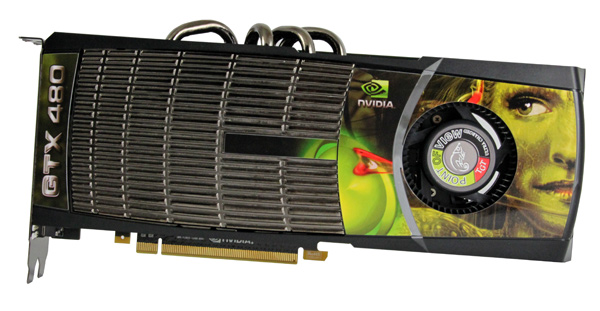
Geforce GTX 480 UC is a dual-slot card, which is common with high end cards, but it is not quite common seeing a reference design with a heatpipe solution. In an effort to deliver thermals that would satisfy the GTX 480’s hot ticker, most of the card’s “hood” is actually the heatsink itself. A glance at Geforce GTX 480 would suggest that the card comes with 4 heatpipes, although the card packs 5 in total.
GTX 480 has TDP of 250W (at idle consumes about 55W) and it needs external power via one 8-pin and one 6-pin connector. The I/O panel features two standard dual link DVI outs as well as one miniHDMI. The card packs a total of 1536MB of GDDR5 memory.

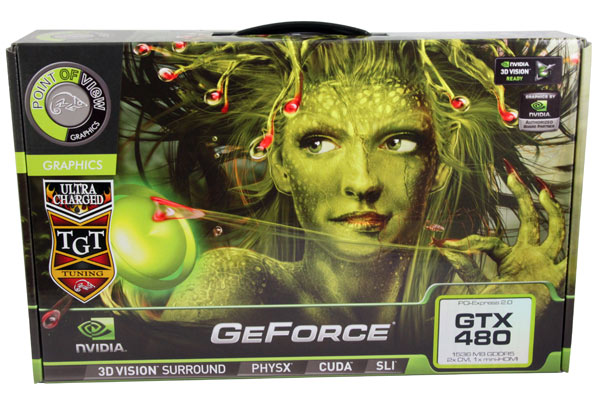
The triple-fan cooler features a total of five heatpipes and 84 fins combined with copper block and three ultra quiet 92mm PWM fans with low noise impeller.
The new POV/TGT "Made in Germany" GTX 480 UltraCharged TFC card should be available in retail/e-tail as of September 20th.
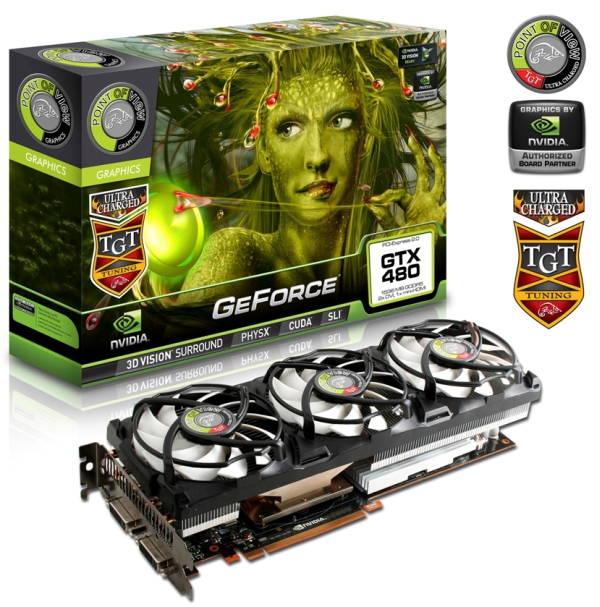
Overclocking
Point of View / TGT GTX 480 Ultra Charged is a factory overclocked card that currently boasts the title of the fastest GTX 480 we’ve tested so far. Unlike the reference card where the GPU runs at 700MHz, shaders at 1400MHz and the memory at 3700MHz, Point of View/TGT Ultra Charged card runs at 763MHz for the GPU, 1536MHz for the shaders and 3800MHz for the memory.
TGT team is in charge of overclocking and of course handpicking the best GF100 chips, the ones capable of hitting 850MHz. Our sample, for instance, has no problem running at 850MHz. We didn’t meddle with voltages nor manual RPM settings; all we did was push a slider in MSI’s Afterburner. The memory ran at 1050MHz (4200MHz effectively), except in Unigine Heaven 1920x1080 Extreme Tesselation test. The results you’ll see on the following tables are measured with the GPU running at 850MHz and memory at 1025MHz (4100MHz effectively).
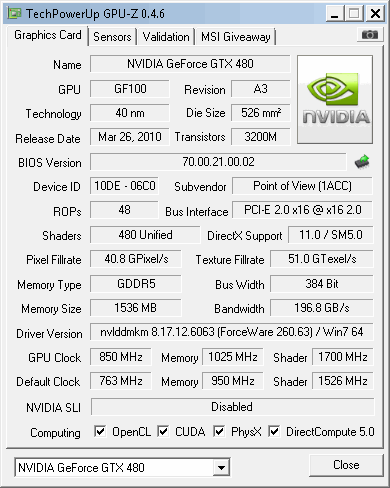
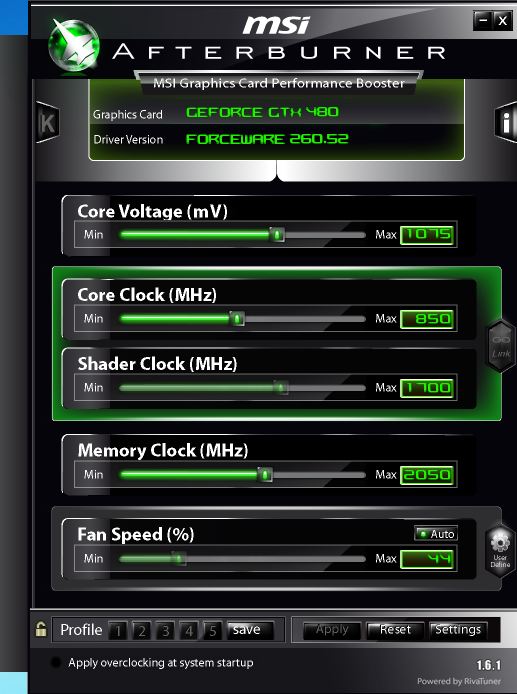
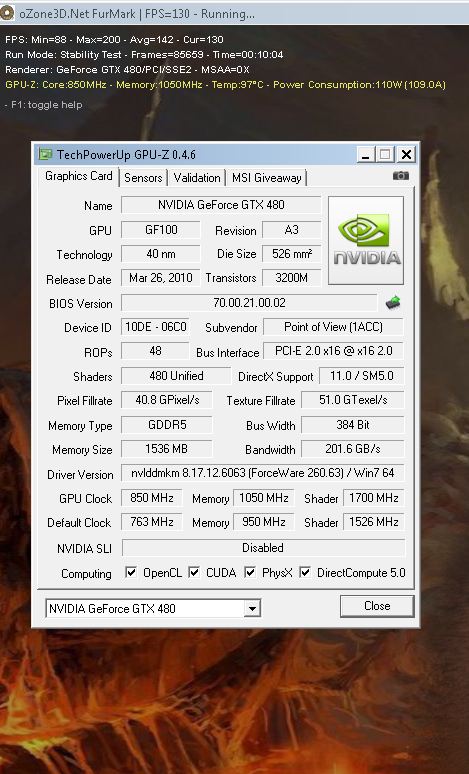
Of course, overclocking the card almost exclusively means higher noise levels, but you should know by now that the cooler is pretty loud, even on reference cards. Consumption increased as well – our test rig strapped with a reference GTX 480 drew maximum 515W; GTX 480 UC pushed this figure to 525W while our overclock resulted in the rig consuming up to 560W.
Testbed:
Motherboard: EVGA 4xSLI
CPU: Core i7 965 XE (Intel EIST and Vdrop enabled)
Memory: 6GB Corsair Dominator 12800 7-7-7-24
Harddisk: OCZ Vertex 2 100 GB
Power Supply: CoolerMaster Silent Pro Gold 800W
Case: CoolerMaster HAF X
Fan Controler: Kaze Master Pro 5.25"
Operating System: Win7 64-bit
260.63_desktop_win7_winvista_64bit_english
10.9 CCC
The following results show results after overclocking. You’ll notice that the GTX 480 UC OC faster than the reference card by 15% to 20%.
3DMark Vantage

Aliens vs Predator
PoV/TGT GTX 480 Ultra Charged outruns the reference GTX 480 by 7%. The difference between the cards was even more evident after overclocking PoV/TGT card as it managed an 18% lead over the reference card.
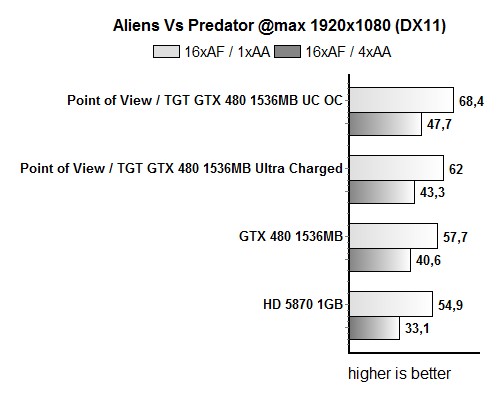
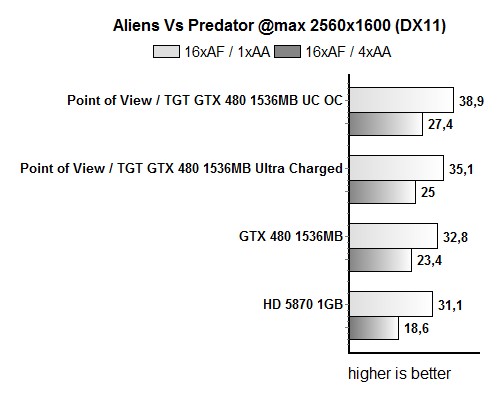
Dirt 2
PoV/TGT GTX 480 Ultra Charged outruns the reference GTX 480 by 7%.
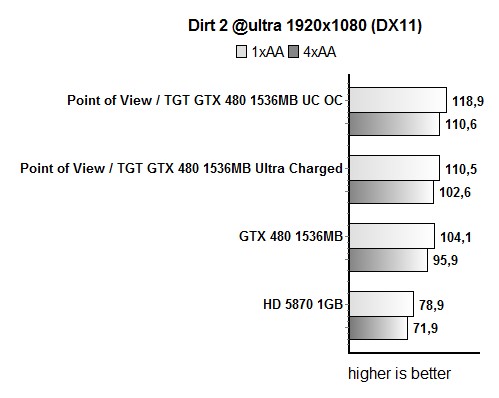
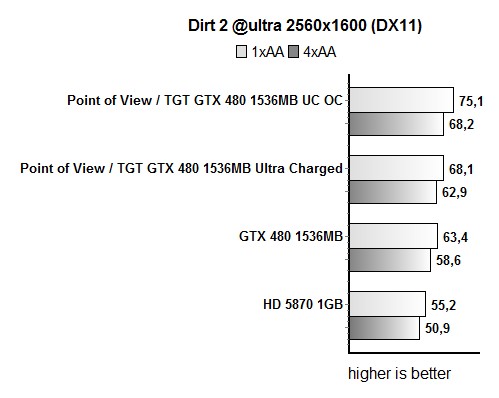
Metro 2033

FurMark

Unigine Heaven v2.1

Conclusion
We must admit that it was pretty refreshing to test a GTX 480 that can be overclocked without much hassle. On the other hand, knowing that it’s a Point of View / TGT GTX 480 Ultra Charged, it wasn’t much of a surprise either. TGT handpicked the crème of the crop GF100 chips and used them on GTX 480 Ultra Charged cards. Hitting 800MHz for the GPU should be a piece of cake for any of these cards. We seem to have been lucky as we managed to push our sample to 850MHz, with no trouble whatsoever, but we can't guarantee that all samples can do that.
Point of View / TGT GTX 480 Ultra Charged is about 7% faster than the reference GTX 480 card and is the fastest factory overclocked GTX 480 we’ve tested so far. After our overclocking, the card scored 15-20% higher than the reference card.
GTX 480 Ulta Chaged runs at 763MHz for the GPU and 950MHz for the memory (3800MHz effectively). The card comes in two flavors – our today’s sample comes with Nvidia’s reference cooling and PoV sticker whereas 20th of September will see the launch of GTX 480 Ultra Charged card with Arctic cooling’s solution. Naturally, you can expect lower temperatures as well as lower noise levels with this card. We must admit we didn’t like the reference cooling, which tends to get pretty loud, and we’re hoping that the new Ultra Charged card won’t be much pricier than our today’s card, which is available at about €460, here.
Performance wise, however, the GTX 480 UC is a beast and will allow for gaming virtually anything. If you don’t mind the noise and the pretty high consumption, then this is the card for you. In case you find the noise to be important, you can wait a bit longer for the GTX 480 Ultra Charged card with Arctic Cooling’s solution as well as the water cooler GTX 480 Beast.


